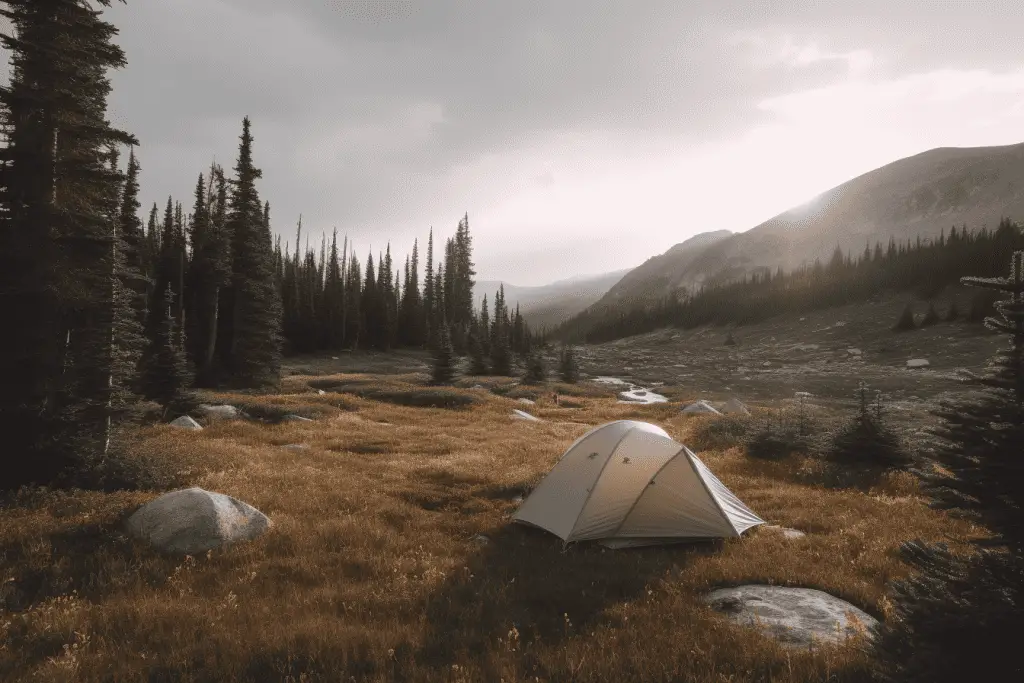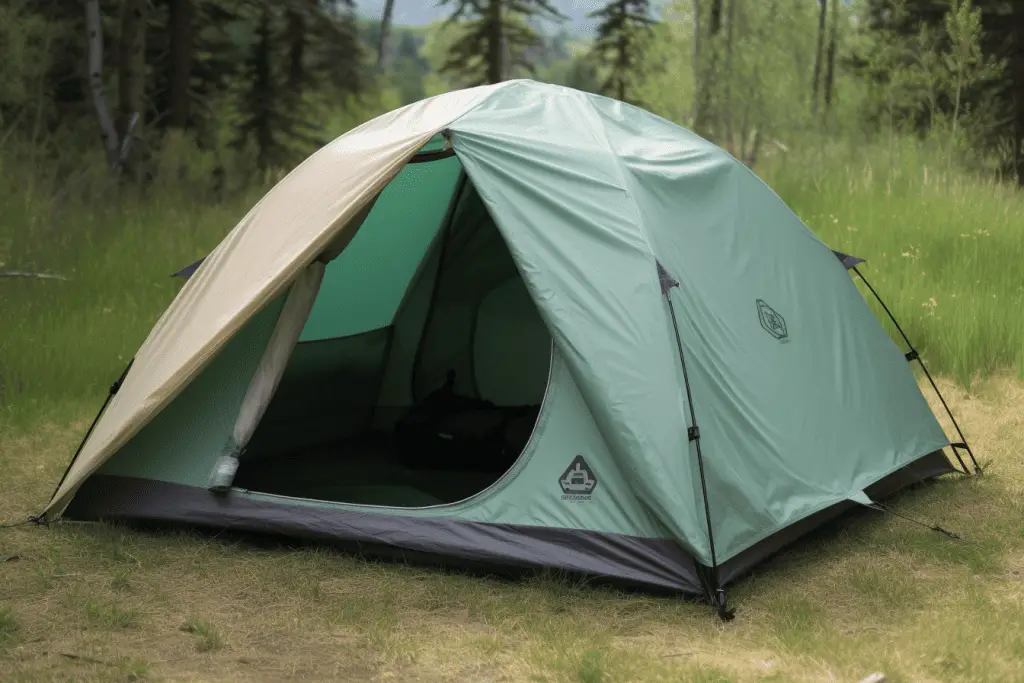Both single wall and double wall tents abound, but which one is better? Who wins the battle between the single wall vs double wall tent? In this post, we’ll discuss each type of tent so you’ll know exactly which tent type is best for you.
Ready to dive into the world of tents? Great! We’ll walk you through all the nitty-gritty – how they’re made, how they handle the elements, their breathability, how easy they are to lug around and set up, their durability, and of course, their price tag. Whether you’re planning a serious wilderness trek or a chill weekend campout, we’ve got you covered. Let’s get into it – single wall vs double wall tents, here we come!

Understanding Single Wall and Double Wall Tents
Alright, let’s kick things off by getting a handle on what we’re actually talking about here – what exactly are single-wall and double-wall tents?
Starting with single wall tents – they’re just what they sound like. They have one layer of fabric between you and Mother Nature. They’re often made from a waterproof, breathable material, making them the lightweight champions of the tent world. These guys are popular with climbers and backpackers who need to keep their packs as light as possible.
Now, onto double wall tents. These tents have – you guessed it – two walls. There’s an inner tent, usually made from a breathable material, and an outer layer, or rainfly, that’s waterproof. This double-layer action makes them great at reducing condensation and providing better insulation – but it does mean they’re a bit heavier. Still, they’re a favorite for many campers and trekkers.
Think of it this way: if tents were clothing, single-wall tents would be your lightweight rain jacket, and double-wall tents would be your warm, fluffy parka. Different gear for different weather, right? But there’s a lot more to it – so stick with us as we dive deeper into the single wall vs double wall tent showdown!
The Basic Construction: What Is A Single Wall Tent?
Let’s start with single wall tents, shall we? Imagine them as the “minimalist” of the tent world. As the name suggests, these tents have just one layer – a single wall – between you and the great outdoors.
This one layer is typically made of a waterproof yet breathable material. Sounds like magic, right? Well, it kind of is! This material helps to keep the rain out while still letting the tent breathe a bit, which can be a game-changer in reducing that clammy feeling on humid nights.
One key feature of single wall tents is their lightweight design. Since there’s only one layer of material, these tents tend to be a lot lighter than their double-walled cousins. They’re often the tent of choice for folks needing to save weight, like climbers and backpackers who don’t want to lug around any extra ounces.
Now, keep in mind that the single-wall design isn’t perfect. The breathability of these tents can vary, and in colder temperatures, you might have to deal with condensation issues. But for the weight-conscious adventurer, they’re a solid option. We’ll get into all the pros and cons later, so stay tuned!
The Advanced Framework: What Is A Double Wall Tent?
Alright, now let’s switch gears and talk about double wall tents. They’re like the “luxury condos” of the tent world, with their fancy two-layer setup. You’ve got an inner tent layer, which is usually breathable, and an outer rainfly, which is waterproof.
The beauty of this double-decker approach is that it’s super effective at reducing condensation inside the tent. Why? Because the breathable inner layer allows moisture to pass through, while the waterproof outer layer protects you from rain and dew. So, no waking up to drips from the tent ceiling. Nice, right?
Another bonus of double wall tents is the insulation. The air trapped between the two walls acts as a barrier, helping to keep you warmer on those chilly nights under the stars.

But keep in mind, these benefits come with a bit of a trade-off – weight. With the extra material, double wall tents are typically heavier than single wall tents. So if you’re planning a long trek, you’ll need to factor that into your pack weight.
Still, for many campers, especially those venturing out in unpredictable weather or off-season, the added comfort and protection of double wall tents make them a top choice. But we’ll dive into all the details in the upcoming sections, so hang tight!
The Advantages and Disadvantages of Single Wall Tents
Let’s jump into the world of single wall tents. These lightweight, often simpler designs are great for certain types of outdoor adventures. But just like anything else, they come with their own set of pros and cons. Below, we’ve put together a quick list to help you understand what single wall tents bring to the table, and some things to keep in mind before making your choice.
Pros of Single Wall Tents:
- Lightweight: They’re made from a single layer of material, reducing the overall weight significantly. Ideal for activities like backpacking or climbing.
- Easy Setup: Fewer parts mean less hassle during setup, allowing for quicker assembly.
- Breathability: Many single wall tents are made from high-tech fabrics that offer a balance of waterproofness and breathability.
- Generally Cheaper: They’re usually less expensive upfront compared to double wall tents.
Cons of Single Wall Tents:
- Condensation: They can struggle with condensation, especially on colder nights.
- Insulation: Single wall tents offer less insulation as there’s only one layer between you and the outside elements.
- Durability: The lightweight materials used may not be as durable or resilient in rough weather conditions.
- Potential Long-term Costs: Although cheaper upfront, potential repair costs down the line should be considered.
Remember, these pros and cons are generalizations – some single wall tents might surprise you! It’s all about finding what suits your camping needs best.
The Advantages and Disadvantages of Double Wall Tents
Let’s shift gears and talk about double wall tents. Known for their extra layer of protection and comfort, these tents can make your camping experience feel a bit more like home. However, they do come with their own unique set of advantages and disadvantages. We’ve compiled a quick list to give you a clear picture of what double wall tents have to offer, and some things you might want to consider before deciding.
Pros of Double Wall Tents:
- Condensation Management: The double-wall design effectively manages condensation by allowing moisture to escape from the inner layer and preventing rain from getting in with the outer layer.
- Insulation: The air trapped between the two walls serves as a barrier, helping to keep you warmer on cooler nights.
- Durability: Typically, double wall tents are built with durability in mind. The extra layer adds resilience against harsh weather conditions.
- Versatility: You can use just the inner tent on clear, starry nights, or add the rainfly when expecting rain, giving you multiple setup options.
Cons of Double Wall Tents:
- Weight: With the added material, double wall tents are typically heavier, which might not be ideal for long hikes.
- Complex Setup: They can be a bit more complex to set up due to the additional layer and parts.
- Cost: Generally, they are more expensive upfront due to the additional materials and complex construction.
- Less Compact: They tend to pack larger due to the extra materials, taking up more space in your backpack.
Remember, these pros and cons are generalities – some double wall tents might defy the norm! Always consider your specific camping needs and preferences when choosing your perfect tent.
Single Wall vs Double Wall Tent: A Side-by-Side Comparison
Here is a quick side-by-side comparison of single wall tents vs double wall tents.
| Features | Single Wall Tents | Double Wall Tents |
|---|---|---|
| Construction | One layer of material | Two layers: inner tent and rainfly |
| Weight | Generally lighter | Generally heavier |
| Breathability | Varies, can be less breathable | Better due to inner layer |
| Condensation Control | Can have condensation issues | Better at reducing condensation |
| Insulation | Less insulation | Better insulation |
| Setup | Usually quicker | Takes longer due to extra layer |
| Durability | Can be less durable | Tends to be more durable |
| Price | Generally less expensive | Generally more expensive |
| Best For | Weight-conscious trips, climbing | Unpredictable weather, camping |
Choosing the Right Tent for You: Factors to Consider
So, you’re ready to choose a tent. But how do you decide between a single wall and a double wall? Here are some key factors to consider:
- Type of Camping: Are you a backpacker, a weekend camper, or a mountaineer? The type of camping you do influences the kind of tent you need. Single wall tents are ideal for weight-conscious backpacking or climbing, while double wall tents are better suited for relaxed camping trips.
- Weather Conditions: Consider the weather you’ll be camping in. Single wall tents work well in dry climates and during summer, but can struggle with condensation in colder weather. Double wall tents are versatile and can handle a broader range of weather conditions.
- Budget: Single wall tents can be more affordable, but they might not offer the durability and comfort of a more expensive double wall tent. Balance your needs and preferences with what you’re willing to spend.
- Weight and Portability: If you need to carry your tent for long distances, a lighter, more compact single wall tent may be the best option. For car camping or shorter distances, a heavier, more spacious double wall tent could be preferable.
- Durability: If you frequently camp in harsh weather or rough terrains, or if you camp often, you may want to invest in a more durable double wall tent. If you only camp occasionally and in fair weather, a single wall tent should suffice.
Remember, the perfect tent is the one that best meets your camping needs and preferences.
Frequently Asked Questions
What is the difference between single wall and double wall tents?
he primary difference is in the construction. Single wall tents are made of one layer of waterproof, breathable fabric, while double wall tents have an inner breathable layer and an outer waterproof layer (the rainfly).
Are single wall tents lighter than double wall tents?
Generally, single wall tents are lighter because they have less material. This makes them a popular choice among backpackers and climbers.
Are double wall tents warmer than single wall?
Double wall tents typically fare better in cold weather due to their superior insulation and condensation management. The air trapped between the two walls can act as an insulator, and the two layers of fabric help manage condensation better.
Are single wall tents cheaper than double wall tents?
While this can vary depending on the specific models and brands, single wall tents are generally less expensive upfront because they require less material to manufacture. However, potential repair costs should also be considered.
Do double wall tents last longer than single wall tents?
Double wall tents usually offer more durability. The extra layer adds resilience against harsh weather conditions, and they are typically made with stronger, heavier materials.
Is a single wall or double wall tent easier to set up?
Single wall tents are typically easier and quicker to set up due to their simpler design and fewer components. Double wall tents require setting up an inner tent and an outer rainfly, which can take more time.
